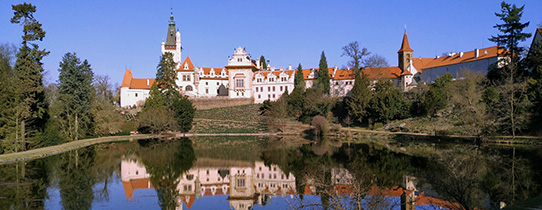Speakers
Markus Fischer (University of Bern, Institute of Plant Sciences, Plant Ecology)
TBA
Petr Kuneš (Department of Botany, Charles University) and Thomas Giesecke (Physical Geography, Utrecht University)
Paleoecological insights into plant population dynamics
Andrew R. Leitch (School of Biological and Chemical Sciences, Queen Mary University of London)
Nucleotype-ecological interactions: How genome size constrains plant distributions
Christina Richards (University of South Florida, Department of Integrative Biology and University of Tübingen, Plant Evolutionary Ecology group)
Using genomics approaches to understand mechanisms of response to complex environmental conditions in non-model plants
Vigdis Vandvik (Department of Biological Sciences, University of Bergen)
Using an experimental macroecological approach to assess climate change impacts on plant populations and communities: experiences, insights, and ways forward
Speaker profiles
Markus Fischer
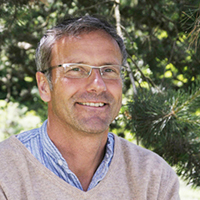 Markus Fischer’s group integrates ecological and evolutionary sciences to assess the causes and consequences of global change. In particular, his group studies the drivers of biodiversity change, the consequences of these changes for ecosystem functions and services, for human societies, and resulting conservation measures. They do so by performing basic and applied plant research, syntheses, comparative studies, experiments, surveys and assessments across scales and environments, and by engaging at the interface between science and policy. Accordingly, the Plant Ecology Lab works in several related areas of interest: plant ecology, biodiversity and conservation, ecological synthesis, and biodiversity-related assessment.
Markus Fischer’s group integrates ecological and evolutionary sciences to assess the causes and consequences of global change. In particular, his group studies the drivers of biodiversity change, the consequences of these changes for ecosystem functions and services, for human societies, and resulting conservation measures. They do so by performing basic and applied plant research, syntheses, comparative studies, experiments, surveys and assessments across scales and environments, and by engaging at the interface between science and policy. Accordingly, the Plant Ecology Lab works in several related areas of interest: plant ecology, biodiversity and conservation, ecological synthesis, and biodiversity-related assessment.
University of Bern, Institute of Plant Sciences, Plant Ecology
Title TBA
Petr Kuneš and Thomas Giesecke
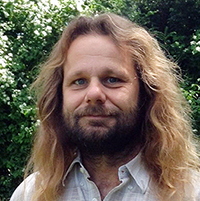
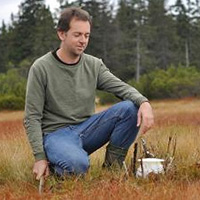
Petr Kuneš studied biology at Charles University in Prague. His doctoral research focused on the palaeoecology of late-glacial and early-Holocene vegetation, and in 2008 he was awarded a PhD at the department of botany. Between 2009 and 2011, Petr worked as a postdoctoral researcher at the Department of Geoscience, Aarhus University, studying past interglacial vegetation dynamics. His research interests lie in the field of Quaternary palaeoecology, connecting ecology, geology and archaeology on various time scales. Petr is particularly interested in studying past ecosystem dynamics and recognising baseline conditions before human impact. He also works on elucidating the drivers of ecosystem change, such as climate or disturbances (fire and human land use) and linking past evidence to modern processes.
Thomas Giesecke received his PhD in 2004 from Uppsala University with the thesis on the spread of spruce in Scandinavia. He is interested in vegetation dynamics and ecosystem change in response to climate and disturbance on time scales of years to millennia, through the study of plant remains preserved in Quaternary deposits. Thomas is working with the European Pollen Database to look at continental scale changes in vegetation composition. Bot on continental and stand scale he tries to disentangle the role of different abiotic drivers and triggers of vegetation change from system internal dynamics.
Paleoecological insights into plant population dynamics
Department of Botany, Charles University, Prague
Physical Geography, Utrecht University
Studying the dynamics of wooded ecosystems consisting of species with lifespans of several centuries requires palaeoecological techniques. Plant remains preserve in lake sediments and peat, which can be dated with an accuracy of years to decades, permit studies of vegetation change on timescales from years to millennia. The dispersal and deposition of pollen grains from wind-pollinated trees have been studied extensively, documenting a linear relationship between changes in the absolute amount of pollen deposited in a lake and the standing volume of trees surrounding the site. The proportional cover of different trees and open vegetation types can be obtained from pollen percentages using models of pollen dispersal and deposition. It is thus possible to study the dynamics of the increase and decline in the population of individual tree species evaluating lag times to environmental forcing or the duration of compositional changes as well as responses to disturbance. Here we present examples of such changes in tree populations. We examine the response to climate change at the end of the last ice age showing that population growth was faster in the south under higher temperatures, while the resident populations may have caused an establishment lag with respect to the new arriving trees. Most of the forests dominated by the shade tolerant Fagus and Picea only formed several millennia after the onset of the Holocene. To which extent the rate of population expansion of these two trees was determined by climate or the resistance of the established vegetation and therefore disturbance regime is still an area of active research.
Andrew R. Leitch
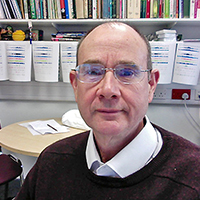 Andrew Leitch is a Professor of Plant Genetics at Queen Mary University of London. He has long standing interests in plant genomics and cytogenetics. His recent work has focused on the evolutionary, ecological and physiological consequence of plant polyploidy and genome size variation. In particular he is exploring the underlying reasons why most plant genomes are small, given the frequency of polyploidy in their ancestry.
Andrew Leitch is a Professor of Plant Genetics at Queen Mary University of London. He has long standing interests in plant genomics and cytogenetics. His recent work has focused on the evolutionary, ecological and physiological consequence of plant polyploidy and genome size variation. In particular he is exploring the underlying reasons why most plant genomes are small, given the frequency of polyploidy in their ancestry.Nucleotype-ecological interactions: How genome size constrains plant distributions
Andrew R. Leitch1, Marie Henniges1, 2, Joseph Morton1, 2, Emily Gu1, 2, Jaume Pelicer2, Maite Guignard1, 2, Ilia J. Leitch2.
1 Queen Mary University of London, London E1 4NS
2 Royal Botanic Gardens, Kew, Surrey TW9 3AB
Genome sizes (GS) vary 2,400-fold across flowering plants, although most species have a small genome (modal GS = 0.6 Gbp/1C; median GS = 2.6 Gbp/1C). This skew towards small genomes is surprising given the high levels of ancestral polyploidy in most angiosperm lineages (e.g. Arabidopsis thaliana is a diploid with a small GS (0.16 Gbp/1C) and yet is predicted to be a paleo-48 ploid). This GS distribution suggests evolutionary selection for small GSs in many plant lineages. Long term nutrient experiments in UK (running > 150 years) and Germany (running > 70 years) indicate that plant species with recent polyploidy and large GS are favoured in the presence of nitrogen (N) and phosphate (P) fertilizers, indicating an N and P cost for large GSs when they are limiting. Given these nutrients are limiting in many soils of the world, the data suggest ecological selection against large GS. There may also be ecological selection against large GS in species growing in arid conditions, and in species with fast generation times. Assuming there is an evolutionary and ecological selection against species with large GS, the question remains as to why this might be so. DNA, and its transcription product RNA are molecules that are rich in N and P, and large genomes may be costly to build and function when these nutrients are limiting. Genomes also occupy a physical volume, which dictates the minimum volume that a cell can occupy, and consequently, GS may have impact on multiple aspects of cell physiology. For example, cell size impacts the gas exchange properties of tissues (e.g. sizes of cell spaces and gas diffusion distances), and be important for water transport and losses Thus, over and above the phenotype generated by the genes themselves, the physical dimensions of the nucleus and the DNA it carries can generate a phenotype in their own right, this the nucleotype can impact plant ecology and generate selection pressures in evolution.
Christina Richards
 Christina Richards received her BA in Biology at Swarthmore College in 1995 and PhD in Botany from the University of Georgia in 2004. She worked with Massimo Pigliucci at Stony Brook University (2004-2006) and then with Michael Purugganan at New York University (2007-2009) as a post-doctoral fellow. Christina’s primary research interests are understanding mechanisms of plant response to novel, stressful or changing environments. She uses genomics and epigenetics approaches in robust ecological experiments to understand how organisms respond to their environment.
Christina Richards received her BA in Biology at Swarthmore College in 1995 and PhD in Botany from the University of Georgia in 2004. She worked with Massimo Pigliucci at Stony Brook University (2004-2006) and then with Michael Purugganan at New York University (2007-2009) as a post-doctoral fellow. Christina’s primary research interests are understanding mechanisms of plant response to novel, stressful or changing environments. She uses genomics and epigenetics approaches in robust ecological experiments to understand how organisms respond to their environment.
Using genomics approaches to understand mechanisms of response to complex environmental conditions in non-model plants.
University of South Florida, Department of Integrative Biology, 4202 East Fowler Avenue, Tampa FL 33620 USA
University of Tübingen, Plant Evolutionary Ecology group, Auf der Morgenstelle 5, D-72076 Tübingen, Germany
Understanding how organisms are able to respond at different time scales is an essential component of deciphering the impact and long-term consequences of a changing environment. Rapidly developing genomic tools for model plants grown in controlled conditions can now be used to examine the mechanisms of phenotypic response in a broad array of wild organisms and biologically relevant conditions. While studies interested in adaptation have largely assumed that trait variation is based on DNA sequence variation, we now know that epigenetic effects can result in heritable, novel phenotypes even without variation in DNA sequence and could therefore provide an unappreciated source of response. I will present data from my lab groups that uses reduced representation bisulphite sequencing and transcriptomic approaches to explore the potential role of genetic and epigenetic processes in the response to challenging environmental conditions in native and invasive populations of Spartina alterniflora and Japanese knotweed. Our work leverages the power of the eudicot Arabidopsis and monocot Brachypodium distychum model plant species to confirm our findings in these non-model plants. Combined, these studies will enhance our understanding of how genetic and epigenetic variation interact in response to environment on different time scales, and ultimately contribute to adaptation.
Vigdis Vandvik
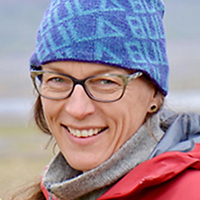 Vigdis Vandvik is professor of plant ecology at the University of Bergen in Norway and leader of bioCEED Centre of Excellence in Biology Education. Her research is focused on how major global change drivers - especially climate and land-use change - affect plants, from their physiological responses via population and community dynamics to ecosystem functioning. She uses experimental macroecological approaches - replicating field experiments across broad geographical and climatic extents - to disentangle causal relationships and and explore context-dependencies and uncover general patterns in these responses. Field experiments offer many opportunities for student-active research, and her research projects are also test-beds for developing effective teaching and learning methods as integral components of 'real' research projects. She is an elected member of the Norwegian Academy of Science and Letters and the Norwegian Technical Science Academy. She communicates science through a variety of channels, and is actively involved in the science-policy interface, both within Norway and internationally, for example as a coordinating lead author on the upcoming Intergovernmental Panel on Biodiversity and Ecosystem Services Invasive Alien Species Assessment (IPBES-IAS).
Vigdis Vandvik is professor of plant ecology at the University of Bergen in Norway and leader of bioCEED Centre of Excellence in Biology Education. Her research is focused on how major global change drivers - especially climate and land-use change - affect plants, from their physiological responses via population and community dynamics to ecosystem functioning. She uses experimental macroecological approaches - replicating field experiments across broad geographical and climatic extents - to disentangle causal relationships and and explore context-dependencies and uncover general patterns in these responses. Field experiments offer many opportunities for student-active research, and her research projects are also test-beds for developing effective teaching and learning methods as integral components of 'real' research projects. She is an elected member of the Norwegian Academy of Science and Letters and the Norwegian Technical Science Academy. She communicates science through a variety of channels, and is actively involved in the science-policy interface, both within Norway and internationally, for example as a coordinating lead author on the upcoming Intergovernmental Panel on Biodiversity and Ecosystem Services Invasive Alien Species Assessment (IPBES-IAS).
Using an experimental macroecological approach to assess climate change impacts on plant populations and communities: experiences, insights, and ways forward
Department of Biological Sciences, University of Bergen, Bergen, Norway, N-5008, vigdis.vandvik@uib.no
Predicting the rate, magnitude, and consequences of ecological responses to unprecedented rates of global environmental change present a pressing challenge for today’s ecologists. Both observational gradient approaches and localized field experiments are making important contributions to our understanding of how biodiversity and ecosystem functions and services are impacted. However, these approaches differ in scope, strengths, and, more fundamentally, also in the underlying ecological questions asked. Differences in outcomes and predictions from different approaches have led to discussions and concerns over their comparability and even validity for answering the pressing global change questions, but also to calls for integrated approaches. I will share experiences and insights from such an integrated approach; replicating experiments to assess climate change impacts on grassland ecosystems and the plant populations and communities that inhabit them across regional-scale climate gradients in Western Norway. Our work illustrates a number of methodological challenges facing climate change ecologists, but also how these approaches can further our understanding of the ecological responses to climate change. In particular, by replicating our climate change experiments along independent temperature and precipitation gradients we can assess and disentangle climate context-dependencies in the responses, and thereby arrive at greater generality about why and how climate change effects vary across landscapes and regions. We manipulate climate per se, but also experimentally isolate the direct and indirect effects of climate change to understand to what extent responses are driven by direct physiological responses to the climatic variables or indirect effects, operating through changes in species’ interactions. In all these studies we explore a variety of responses, from physiological responses via plant population dynamics to community composition, plant functional traits, and ecosystem functioning. This allows us to explore how effects scale across these levels of biological organization.
Keywords: ecosystem transplant experiments; extinction; global change; invasion.


